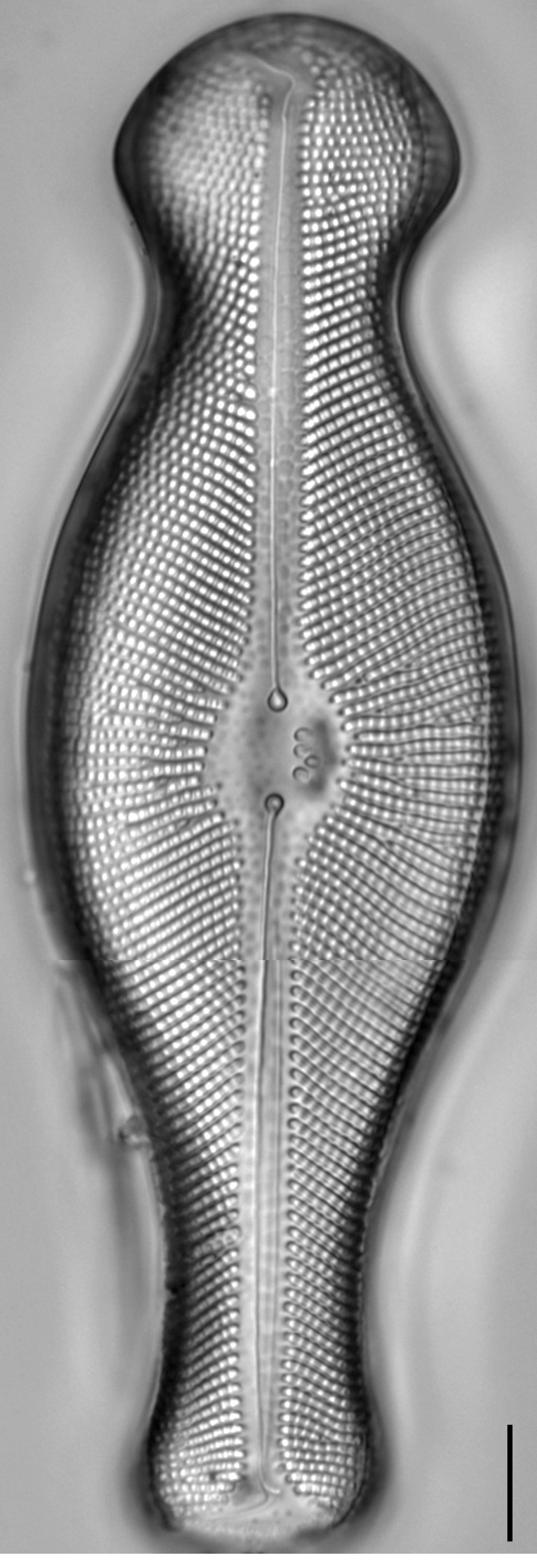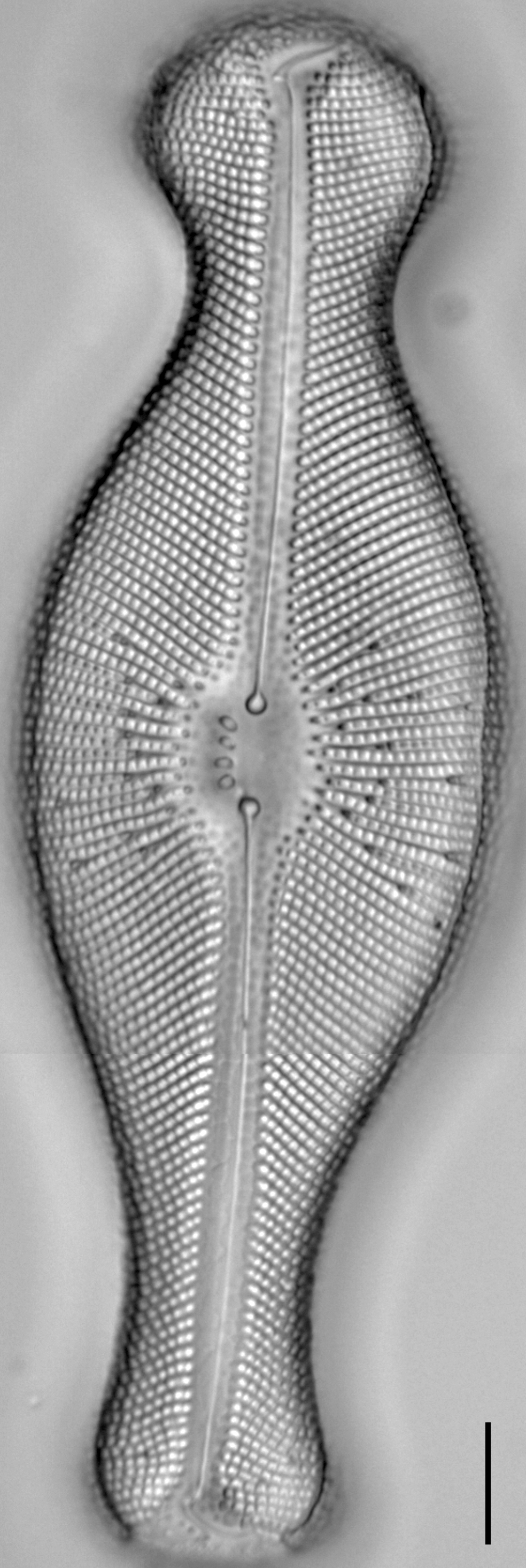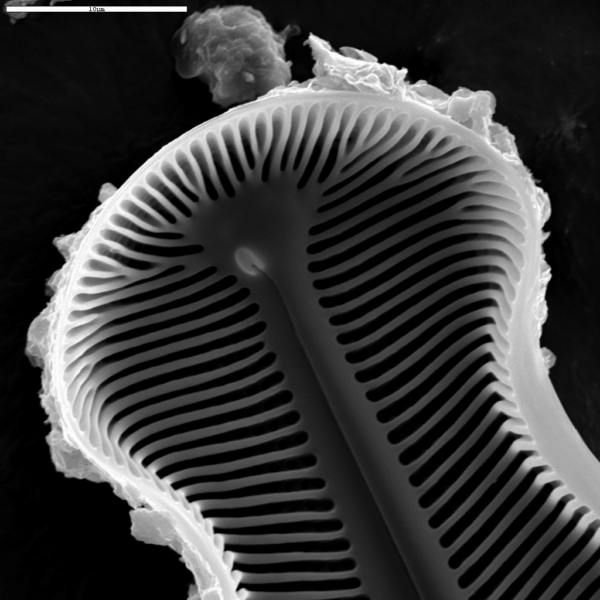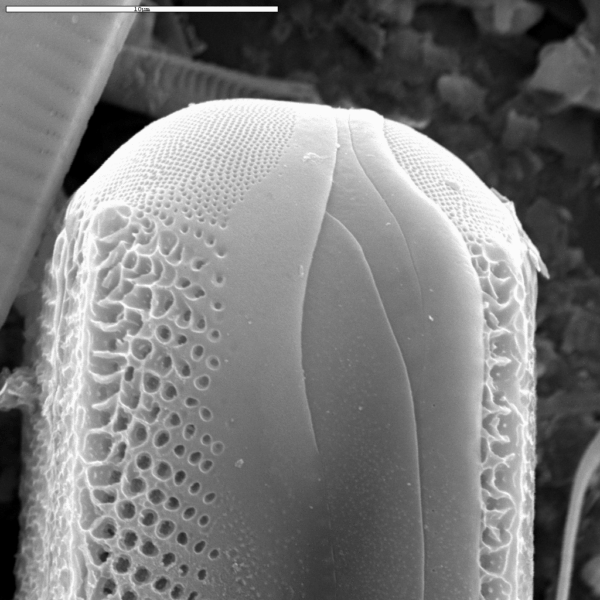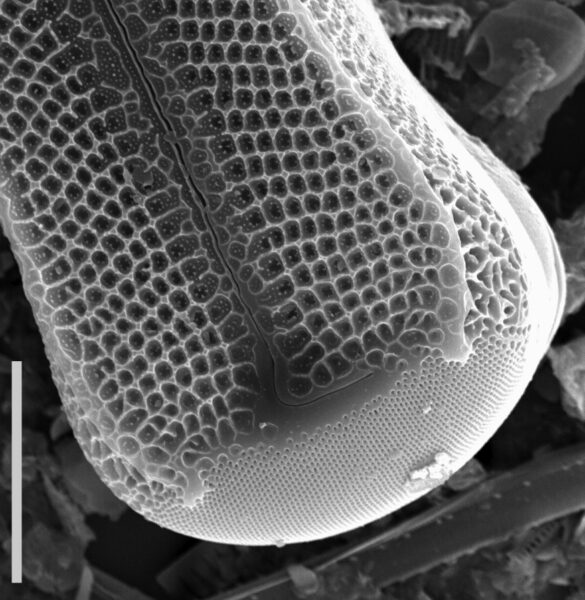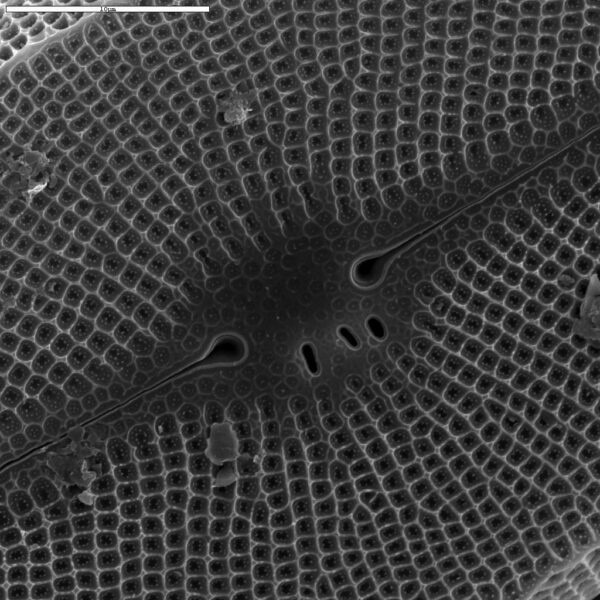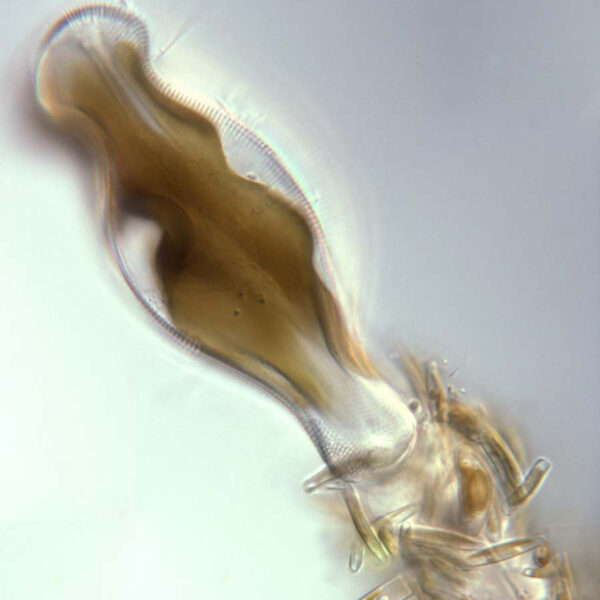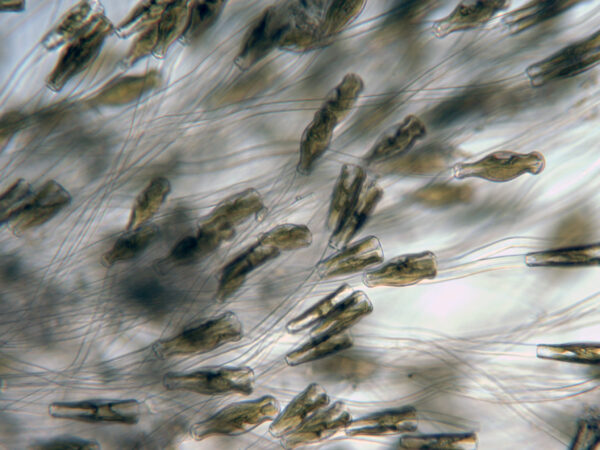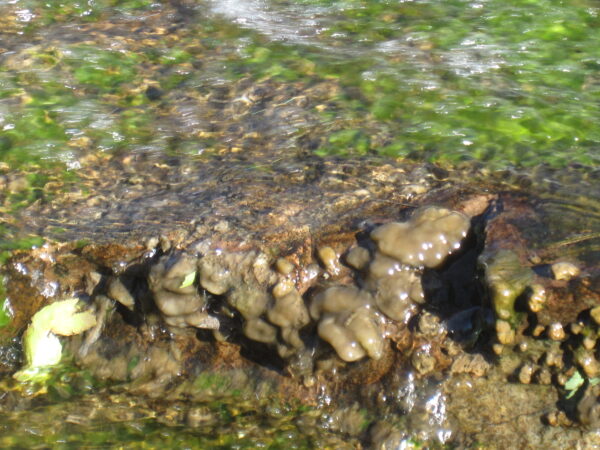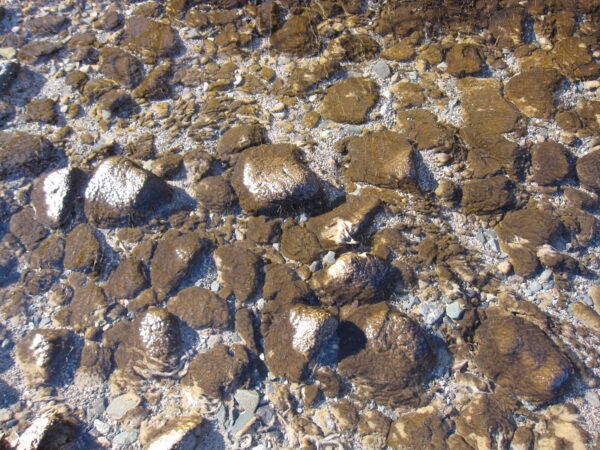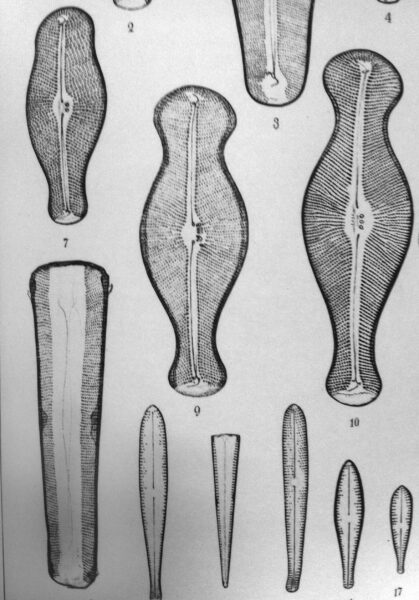Didymosphenia geminata
-
Category
-
Length Range65-161 µm
-
Width Range36-41 µm
-
Striae in 10 µm7-9 in the center valve
-
SynonymsEchinella geminata Lyngb. 1819
Gomphonema geminatum (Lyngb.) C.Agardh
-
Reported Asdidymo (common name)
rock snot (common name)
-
ContributorSarah Spaulding - Nov 2010
-
ReviewerMarina Potapova - Apr 2012
Identification
Description
Valves are large, robust and slightly asymmetric to the apical axis. One end of the valve forms a distinct, capitate headpole. The other end of the valve, the footpole, is less capitate to bluntly rounded. The axial area is relatively linear and the central area is an expanded oval. Stigmata number 2-5, with the number of stigmata positively related to valve size. Internally, the stigmata possess convoluted internal occlusions. The raphe is lateral, with expanded proximal raphe ends and deflected distal raphe ends. The distal raphe is deflected near the porefield at the footpole, but does not pass through the porefield. The porefield is large, distinct and composed of fine porelli. The areolae are complex; externally the areolae are within ornamented depressions, internally the areolae open with chambers. The striae are radiate for most of the valve, except near the footpole, where they become nearly parallel. Striae near the valve center are irregular and many do not reach between the central area and valve margin. Under the SEM, a ridge of silica is present between the valve face and margin. This ridge may be expanded into small spines at the headpole.
Didymosphenia geminata is the only species within the genus that has been documented in the lower 48 states, but D. clavaherculis has been documented from Alaska (Metzeltin and Lange-Bertalot, 1995; Pite et al. 2009). Some populations may show greater asymmetry to the apical axis, while others may be nearly linear. The sister taxa to the genus Didymosphenia include Cymbella mexicana and Cymbella janischii (Kociolek and Stoermer 1988).
The range in length posted here is based on measurement of over 90,000 valves over a one year period from South Boulder Creek (Bishop, M.S. Thesis, University of Colorado, 2014).
Autecology
Didymosphenia geminata is known by the common name, 'didymo'. It attaches by a mucopolysaccaride stalk to benthic substrates in flowing waters and splash zones of lakes. In some rivers, cells of D. geminata produce large amounts of stalk, so large that river bottoms may become covered by a thick felt. The stalks may become long and stringy, forming white strands up to 1 meter long. Such nuisance "blooms" have been increasing in extent in North America and Europe (Blanco and Ector 2009). In New Zealand, Chile and Argentina D. geminata is an invasive organism (Kilroy and Bothwell 2011, Reid et al. 2012).
Bothwell first presented the compelling paradox that nuisance blooms of D. geminata occur only in oligotrophic rivers, and the observation has since been elaborated on by others (Kirkwood et al. 2007, Kilroy and Bothwell 2011). The observation of high biomass in low nutrient waters goes against the traditional positive relationship of algal biomass and nutrient concentration. The causes of large amounts of stalk production by this diatom have been understood as either “photosynthetic overflow” (Kilroy and Bothwell 2011) or as a means for uptake of phosphorus (Sundareshwar et al. 2011). Further work is needed to resolve the role of stalk production in D. geminata and the understanding the global expansion of this diatom and the ecologically important role of stalk production in the diatoms as a whole.
-
Size Range, µm3
-
Motility
-
Attachment
-
Habitat
-
BCG
-
Waterbody
-
Distribution
- Learn more about this
Citations & Links
Citations
-
Publication Link: 10.1007/s10750-012-1193-y
-
Publication Link: 10.1093/biosci/biu226
-
Publication Link: 10.1111/jpy.12528
-
Publication Link: 10.1127/0029-5035/2009/0088-0347
-
Publication Link: 10.1111/j.1365-2427.2010.02524.x
-
Publication Link: 10.1080/0269249X.2022.2047793
-
Publication Link: 10.1111/j.1529-8817.2011.01029.x
-
Publication Link: 10.1111/j.1365-2427.2011.02727.x
-
Publication Link: 10.1002/ece3.3572
-
Publication Link: 10.1111/j.1529-8817.1988.tb04480.x
-
Publication Link: 10.1890/080054
-
Publication Link: 10.2216/14-002.1
-
Publication Link: 10.1007/s00027-019-0681-9
-
Publication Link: 10.1007/s10750-019-04168-y
Links
-
Index Nominum Algarum
-
GenBank
-
North American Diatom Ecological DatabaseNADED ID: 81001
Cite This Page
Spaulding, S. (2010). Didymosphenia geminata. In Diatoms of North America. Retrieved November 21, 2024, from https://diatoms.org/species/didymosphenia_geminata
Responses
The 15 response plots show an environmental variable (x axis) against the relative abundance (y axis) of Didymosphenia geminata from all the stream reaches where it was present. Note that the relative abundance scale is the same on each plot. Explanation of each environmental variable and units are as follows:
ELEVATION = stream reach elevation (meters)
STRAHLER = distribution plot of the Strahler Stream Order
SLOPE = stream reach gradient (degrees)
W1_HALL = an index that is a measure of streamside (riparian) human activity that ranges from 0 - 10, with a value of 0 indicating of minimal disturbance to a value of 10 indicating severe disturbance.
PHSTVL = pH measured in a sealed syringe sample (pH units)
log_COND = log concentration of specific conductivity (µS/cm)
log_PTL = log concentration of total phosphorus (µg/L)
log_NO3 = log concentration of nitrate (µeq/L)
log_DOC = log concentration of dissolved organic carbon (mg/L)
log_SIO2 = log concentration of silicon (mg/L)
log_NA = log concentration of sodium (µeq/L)
log_HCO3 = log concentration of the bicarbonate ion (µeq/L)
EMBED = percent of the stream substrate that is embedded by sand and fine sediment
log_TURBIDITY = log of turbidity, a measure of cloudiness of water, in nephelometric turbidity units (NTU).
DISTOT = an index of total human disturbance in the watershed that ranges from 1 - 100, with a value of 0 indicating of minimal disturbance to a value of 100 indicating severe disturbance.
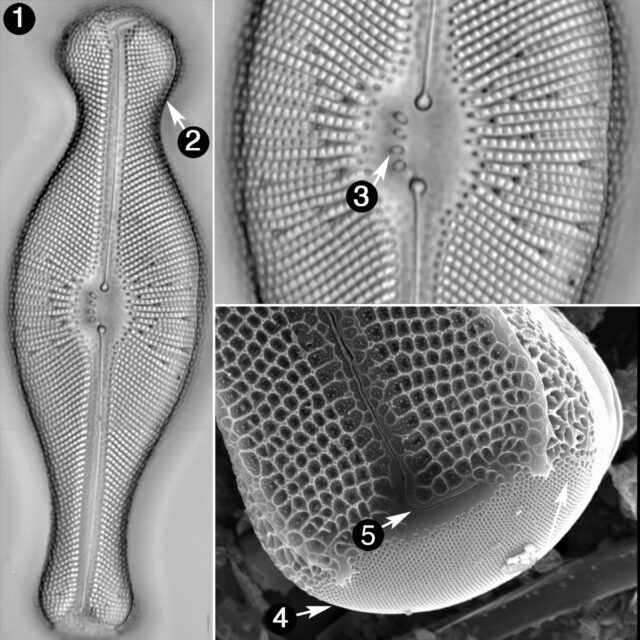
Didymosphenia geminata
- Valves large
- Headpole capitate
- Stigmata 2-5
- Apical porefield present
- Distal raphe deflected
The valves are large and robust. The headpole is distinctly capitate, while the footpole may be capitate or not. The number of stigmata is variable, but depends on valve size. A porefield is present at the footpole. The distal raphe is deflected at the footpole, rather than bisecting it.
 Diatoms of North America
Diatoms of North America
